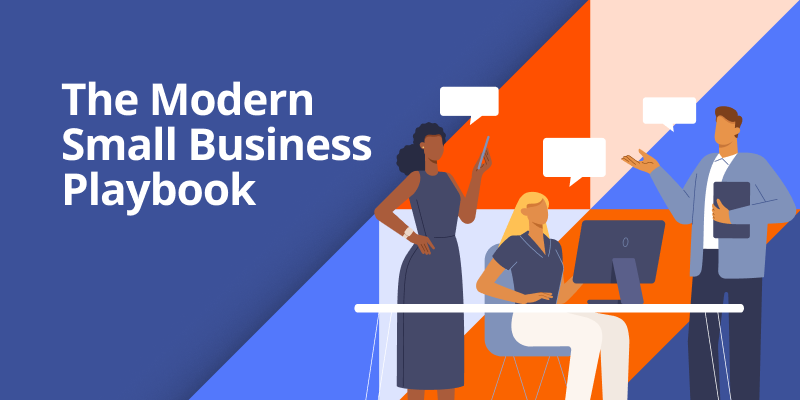Marketing moves fast, and every day, a new trend or tool seems to pressure small business owners to go viral.
Going viral is great, but it’s not something you can hedge your bets on. Instead, invest in a long-term strategy that’s much more reliable for small businesses – like growth marketing.
Kick customer growth into high gear.
Small business marketing software to boost your online presence, understand your audience, and make data-driven decisions.
Learn More
Growth marketing turns positive customer interactions into sales and loyalty. It doesn’t revolutionize your business overnight, but it does help you expand your customer base and attract new clients.
In this post, we’ll discuss the basics of growth marketing, including how small business owners can start doing it and examples of successful growth marketing campaigns.
What is Growth Marketing?
Growth marketing uses data to foster and accelerate growth. It’s a long-term marketing strategy that relies on campaigns and experiments, such as A/B testing, to inform decisions at your business.
Growth marketing aligns with the “marketing funnel” that guides people through their customer journey. They interact with new messages at each step that move them closer to purchasing. It encompasses things like customer loyalty, brand awareness, and engagement. Growth marketing aims to capture and retain as many leads (potential customers) as possible.
Why is Growth Marketing Important for SMBs?
The goal of growth marketing campaigns is to create long-term, sustainable growth. Rather than relying on instincts, creativity, or outdated marketing strategies, growth marketing allows small businesses to adapt quickly to their customers’ preferences or marketplace changes.
Small businesses must retain and attract new customers to create sustainable revenue. Large companies have big budgets and tons of resources they can use to create comprehensive marketing campaigns. Growth marketing gives small businesses the chance to use the same strategies, but with fewer resources.
Even though you don’t have the same budget, you can test at scale and collect data that informs your strategy. Engaging in growth marketing makes a business more competitive and gives it invaluable tools for attracting customers and creating revenue.
Here’s where something like a business management platform, which helps you organize tasks and operations, can be valuable. These platforms give you access to data that can grow your business, like customer reviews, booking and scheduling rates, website traffic, and more. And that information can help you get more out of your marketing efforts and channels, like local business listings and social media pages.
AARRR Framework
Venture capitalist, Dave McClure, created the acronym AARRR to measure how customers enter and stay in a marketing funnel. AARRR stands for Acquisition, Activation, Retention, Referral, and Revenue.
Each part of AARRR corresponds with a section of the growth marketing funnel, and helps explain how it works and where regular experimentation fits in.
In a growth marketing framework, customers take steps through AARRR:
- Acquisition occurs when a customer becomes interested in your product or service. This stage can also be called “discovery” because the customer is discovering your brand.
- Activation is when the customer takes an action the brand wants, such as signing up for a trial or browsing products on your website.
- Retention is the stage where brands try to connect with customers using information they now have (pages visited on your website, emails opened, etc.). Based on this information, they can send personalized email marketing or discounts.
- Referral is when brands give current customers an incentive to bring in new customers. It’s a cost-effective way to grow your customer base and keep loyal customers happy.
- Revenue is the stage where brands look at what they’ve been doing and see which efforts are helping them make more money.
Key Elements of Growth Marketing
You should familiarize yourself with these important elements of growth marketing.
Complementary Marketing Channels
One of the key parts of growth marketing is using more than one communication channel to keep audiences engaged and make sure your marketing messages are reaching as many people as possible. This is called “omnichannel” marketing, and many big brands use it to improve customer experiences.
For instance, think about Starbucks’ mobile pickup. You engage with the brand online and then in person. Both experiences are tailored to your preferences and help you make a purchase.
A small business can use omnichannel marketing in a similar way. For example, you can offer in-person discounts for online referrals, or develop a customer loyalty program that let customers accumulate points through online purchases or another digital channel.
A/B Testing
A/B testing is when you compare two different versions of a marketing element to see which one works best. You can compare almost anything in an A/B test – subject lines in an email, website headers, or a graphic in a social media ad.
An A/B test is a bit like a science experiment. One part, A, is the control – the thing that stays the same – and the other part, B, is the variant you’re testing. For example, we might test a form on our website against a new version with different fields or styling. We would then come up with a hypothesis for which version we think will perform better.
Small businesses like to stay lean, so A/B testing can be a really effective growth marketing strategy – having a well-thought-out test will help you make sure marketing efforts are working. You don’t have to test all the time, but when you do, ensure it’s something you really want to know and can gather solid data. A/B testing can be really helpful to small businesses as you develop your email marketing strategy, for example. You can use it to test different types of content and perfect your style and tone, helping you get the most out of your emails.
Experimentation
Growth marketing requires regular, if not constant, experimentation – and that goes beyond A/B testing. Your experiements should be based on a growth plan; that is, where you want your business to go and how you want to get there. Experiment with everything in your marketing campaigns, like your social media copy and your website’s graphics. See what customers respond to, then use A/B testing to fine-tune future campaigns.
For example, let’s say you manage a retail store. First, think about where most of your customers come from. Is it through online ads, foot traffic, or referrals?
If you don’t know, there are ways to find out. Use customer surveys and ask people how they heard about your business. Once you have that data, you can conduct experiments to grow the channels where you want to attract more customers – like running promotions to get more people in your store, or doubling down on the most popular social media channels where people are discovering your business.
Depending on the result, you could run search ads, social media ads, or even create flyers. The most important thing is that you keep testing, seeing what works, and optimizing those opportunities for growth until you fully understand your customer funnel.
Customer Engagement & Retention
Getting new customers is just one piece of growth marketing. Another important part is customer retention, or what you do to keep the customers you have.
You can measure customer retention in a few different ways. The best place to start is your CRM. It can tell you how long people have been customers of your business their different interactions with your company. You can also look at customer satisfaction scores, customer referrals, and reviews of your business to see how people feel about your products and services.
One advantage small businesses have is being able to focus on individual customer care, and growth marketing allows you to gather data and adapt to your customers’ needs. The critical part is paying attention to and responding to those needs – however they come to your attention.
Customer Journey
Once customers are in your marketing funnel, there’s no guarantee they’ll stay there. Think about abandoned carts. These customers were interested enough to add products to their shopping list, but somewhere they lost interest and moved on to something else.
Growth marketing focuses on getting customers into the funnel and keeping them there all the way to purchase. You do this by nurturing customer relationships and keeping them engaged with your brand. We call this “the customer journey,” and it’s important to understand how it plays out in your business. That will help you spot timely marketing opportunities to improve customer relationships.
Some of the customer journey may happen offline for small businesses, and that’s okay. Your data may tell you, for instance, that offline marketing is the best way to engage your customers. Be willing to experiment, respond to customer behavior, and listen to the story your data tells you over time.
Growth Marketing Examples From Real Companies
These brands are household names, but they didn’t start out that way. They each used growth marketing to go from underdog to industry leader — and here’s how.
1. Harry’s
Harry’s used growth marketing to compete against major drugstore brands like Gillette. Before you could buy Harry’s razors in stores, it gained customers through a long-term relationship with a subscription model. Customers would pay a flat rate and receive a new set of razors each month. It was cheaper than drugstore brands, and you didn’t have to go to the store to buy them.
At the time, subscriptions were gaining popularity, and Harry’s predicted that the subscription industry would continue to grow. The company was right: the global subscription box market is expected to reach $71.77 billion by 2028, and the industry continues to grow each year.
Harry’s used industry data to determine the best product pricing and offered quality razors at a competitive price point. It also focused heavily on appealing to its target audience with creative advertisements like this one, promoting the brand’s launch in London:
Overall, Harry’s is a great example of how a medium-sized business grew into a household brand with the help of growth marketing.
2. The Farmer’s Dog
The Farmer’s Dog is a human-grade dog food brand that prepackages meals and delivers them to your door. Founded in 2014, it generates hundreds of millions in revenue annually.
The Farmer’s Dog marketing strategy leans on its customer reviews. Since pet owners trust other pet owners for recommendations, The Farmer’s Dog puts glowing customer feedback front and center for its audience.
Notice how these comments address specific customer concerns. The one from Marina is a great example. The Farmer’s Dog costs more than your average store brand, but you’ll potentially save more with fewer trips to the vet. The other one from Catherine talks about how her dog looks healthier and has more energy since eating The Farmer’s Dog food.
These themes of health and security are even present in the brand’s video marketing. For example, its Super Bowl ad featured a dog experiencing a healthier, happier life because its owner fed it The Farmer’s Dog (heartwarming content warning):
These messages position The Farmer’s Dog as a healthier alternative to traditional dog food. This growth marketing strategy is effective because it creates an emotional connection with its audience and generates a time-sensitive need for the brand’s product.
3. Topgolf
Topgolf is one of the fastest-growing entertainment brands in the U.S. It generated about $1.6 billion in 2019 and exceeded $4 billion in 2023.
If you’re unfamiliar with Topgolf, it’s a bar, a driving range, and an interactive arcade, all in one. Don’t play golf? No worries. Topgolf isn’t for serious golfers. It’s for people who want to have fun, get refreshments, and play games like Angry Birds with their friends.
That’s also how Topgolf has become so popular. Its demographic isn’t professional golfers, but average consumers who are looking for a fun night out. Topgolf’s marketing strategy caters to these individuals by using messages like “Find your crew” and “Crush it!” Its website uses plenty of images of happy customers high-fiving their friends and enjoying different games.
There’s also the Topgolf app, which logs your scores and game history. You can use it to book reservations, order food, or see where your scores stack up on the national leaderboard. Not only is it handy, but the app generates more revenue for the business.
Between the brand partnerships, the relevant content marketing, and the state-of-the-art service technology, Topgolf has become a case study for effective growth marketing.
Growth Marketing for Small Businesses
Looking at the examples, you might think these businesses are on a completely different playing field. But, they had to start somewhere, and most of them were smaller businesses like yours that grew into the household brands they are today. These companies were successful because they leveraged data effectively and listened to their customers. Do the same at your business and use the tips above to launch a successful growth marketing campaign.

Modern Small
Business Playbook
Modernize your business, get paid faster and win more customers.








